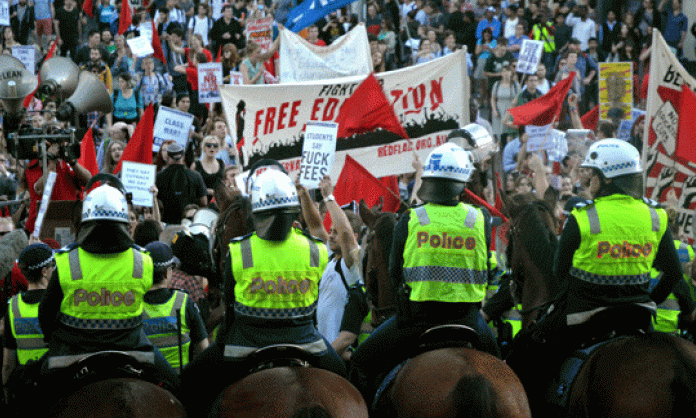This year the most sustained and successful student campaign in almost a decade took place. It combined mass protests with direct action and gained ongoing media coverage and public support. Most importantly, seven months after the release of the budget, the government has not been able to legislate for the deregulation of university fees. NUS National Education Officer Sarah Garnham reports.
----------
Top 10 moments of student protest
1. The biggest national student protest since 2005 took place on 21 May. Five thousand students marched in Melbourne, 3,000 in Sydney and hundreds in other cities around the country against education minister Christopher Pyne’s plan to deregulate university fees. Images of students marching, occupying intersections and burning copies of the budget were streamed onto the nightly news in city after city.
2. On the same day, Pyne and Abbott cancelled their visit to Deakin University, citing the student national day of action as the reason. This was the first of a series of cancelled engagements by senior ministers, due to fear of confrontation with angry students.
3. On 5 May, student activists joined the Q&A audience and drowned out the mind-numbing chatter between Pyne and program host Tony Jones. Jones responded to the rowdy protest by evicting the students and accusing them of not obeying the dictates of democracy. The protest received widespread support and was the chart topper in the Age newspaper’s compilation of “most memorable Q&A milestone moments of 2014”.
4. On 21 August, 500 students protested against Tony Abbott’s visit to Adelaide University. Despite the fact that the university had installed two-metre fencing to protect the hated PM, students broke into the designated area before being dispersed by mounted police. Abbott was forced to scuttle off the premises via an underground route.
5. On 21 May, New Matilda revealed that Frances Abbott had received a secret $60,000 scholarship from the Whitehouse Institute of Design. The institute’s owner, Leanne Whitehouse, had lobbied the PM last December for public finding to private institutions – a measure that the government included in its budget package on education. There is no evidence that the scholarship was offered to anyone else or that it has ever been awarded before. The revelation gave extra purpose to the campaign.
6. On 12 September, 300 students protested against Abbott at Melbourne University. The protesters blocked all of the entrances to the building and chased his chauffeur-driven car down the road as he fled the scene.
7. On 16 May, students bailed up foreign minister Julie Bishop on her way to deliver a lecture at Sydney University. Though Bishop was surrounded by body guards, she was forced to listen to the students’ shower of insults against her and her government.
8. Hours later, Bishop attempted to give another speech, this time at UTS, and was mobbed once again. These two protests gained significant coverage on every major news channel.
9. On 28 August, students in Melbourne occupied Liberal Party headquarters and intercepted a delivery of wine worth $3,000.
10. In Perth, hundreds of students from across the country came to the National Union of Students Education Conference to discuss the way forward at activist workshops and seminars led by trade union militants and other activists.
----------
Rebuilding a culture of student protest
This list is only a selection of the many and varied student actions undertaken this year. In every state, student activists have been taking every opportunity to raise opposition to the government’s attacks on education.
Thousands of students have been involved.
Following the introduction of voluntary student unionism in 2005, the student movement lay dormant for many years. Unions became timid and passive and refused to use their resources to mobilise students against government attacks.
There’s a long way to go to rebuild traditions of protest and activism on the campuses and within our student unions. But big student demonstrations last year against the Labor government’s funding cuts, and the sustained and vibrant campaign this year, have taken some steps in that direction.
A strategy to rebuild the student movement
The audacity of the student campaign this year captured the public eye and created a lightning rod for the broader anti-budget sentiment.
The budget was far reaching in its attacks on workers and the poor, yet the attacks on students have received disproportionate attention and have been some of the hardest for the government to sell.
This was not inevitable. When the budget was first released, only 43 percent of the population opposed the deregulation of fees (it was one of the least opposed measures), and the ALP and PUP did not immediately pledge their opposition.
Today, opposition to fee deregulation is second only to opposition to funding cuts to hospitals, and Pyne is the most unpopular senior government minister.
The key debate in the campaign has been about the purpose of protests. More conservative forces have focused on lobbying Palmer and the other cross-benchers and on creating online petitions. The campaign itself has refuted this orientation; it has proved the importance of mass mobilisations and direct action in applying pressure to the politicians. Despite this, the issue is not settled.
A new campaign called “Brighter Future” has been established by some people within the National Union of Students. It will have a focus on online awareness-raising and lobbying and will campaign for federal Labor’s re-election in 2016.
We’ve seen this movie before. Such a strategy will demobilise and kill the campaign and leave the student movement weakened and open to more attacks in the future.
The other important and longstanding debate is over the role of vice-chancellors. The vice-chancellors, particularly those at Group of Eight universities, have been some of the most enthusiastic proponents of fee deregulation.
On 24 November the Australian published an open letter, written by Belinda Robinson, CEO of Universities Australia, imploring senators to vote in favour of deregulation.
Universities Australia has always been, and continues to be, a voice of reaction in debates around education and students rights.
Yet Robinson was invited as a guest of honour to the National Union of Students presidents’ summit this year. The idea that there is any room for positive engagement between the National Union of Students and Universities Australia is absurd at the best of times. It is even more ridiculous when they are arguing for the cost of a degree to double or triple.
Where to next?
The student campaign needs to continue in earnest in 2015. The start of the campus year is a key opportunity to talk to students about the government’s plans and to convince them to be involved in fighting back.
We need to organise a national day of action early in semester one and publicise it widely from January. It’s also a priority for student activists and education officers to look for opportunities for direct action, both off and on campus.
The vice-chancellors are our other enemy in this campaign, and they also have no right to conduct their business freely while advocating the impoverishment of thousands of students. If deregulation is passed, we will need to campaign against the vice-chancellors to prevent them from raising fees.
Regardless of the status of the fee deregulation legislation next year, we need to be clear that the government and the vice-chancellors are hungry and impatient for the full privatisation of the university system.
Students need to be on a war footing if we are going to have any chance of repelling this agenda. We need to maintain the momentum that we have developed this year and continue to rebuild the student movement with confidence.









